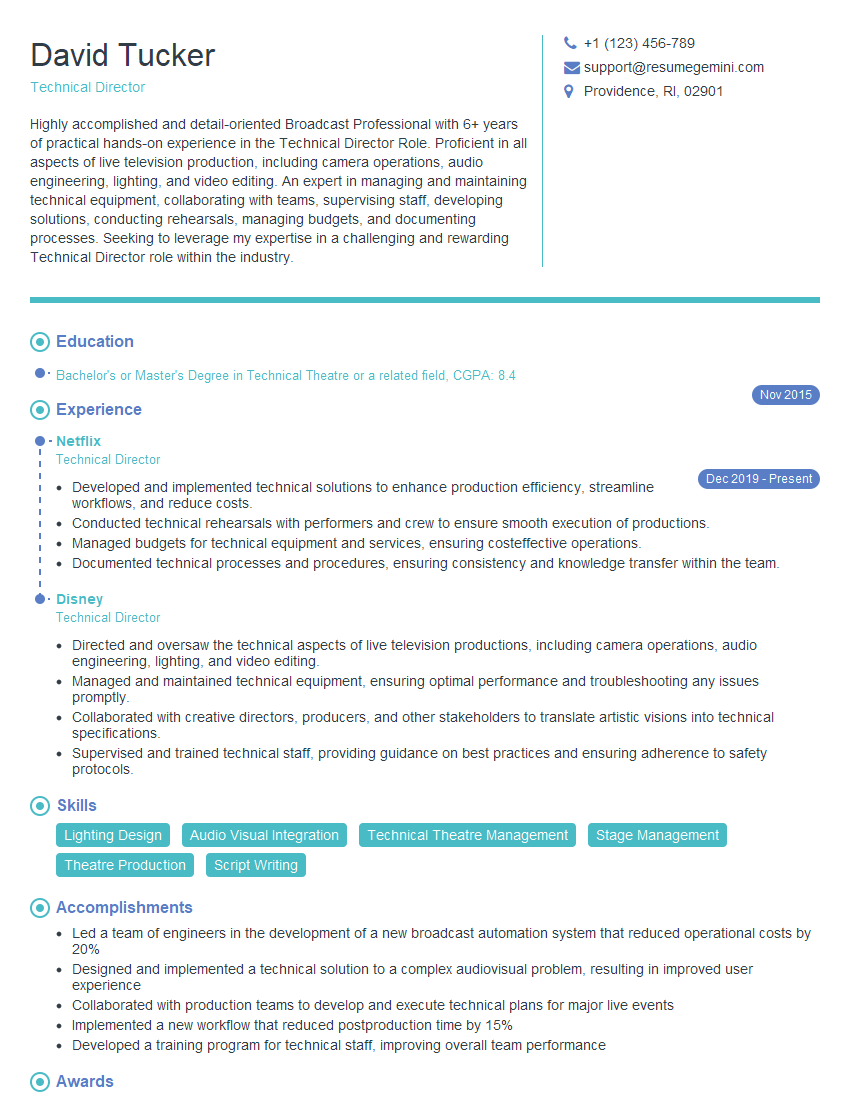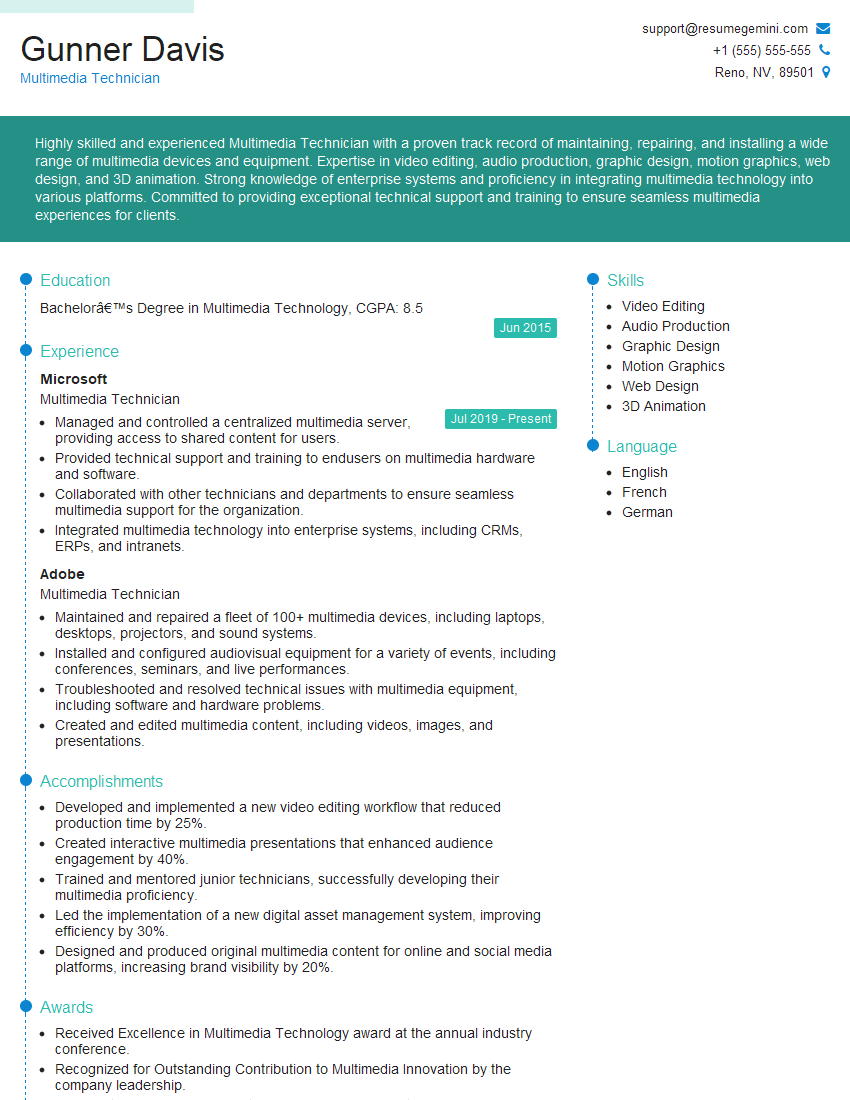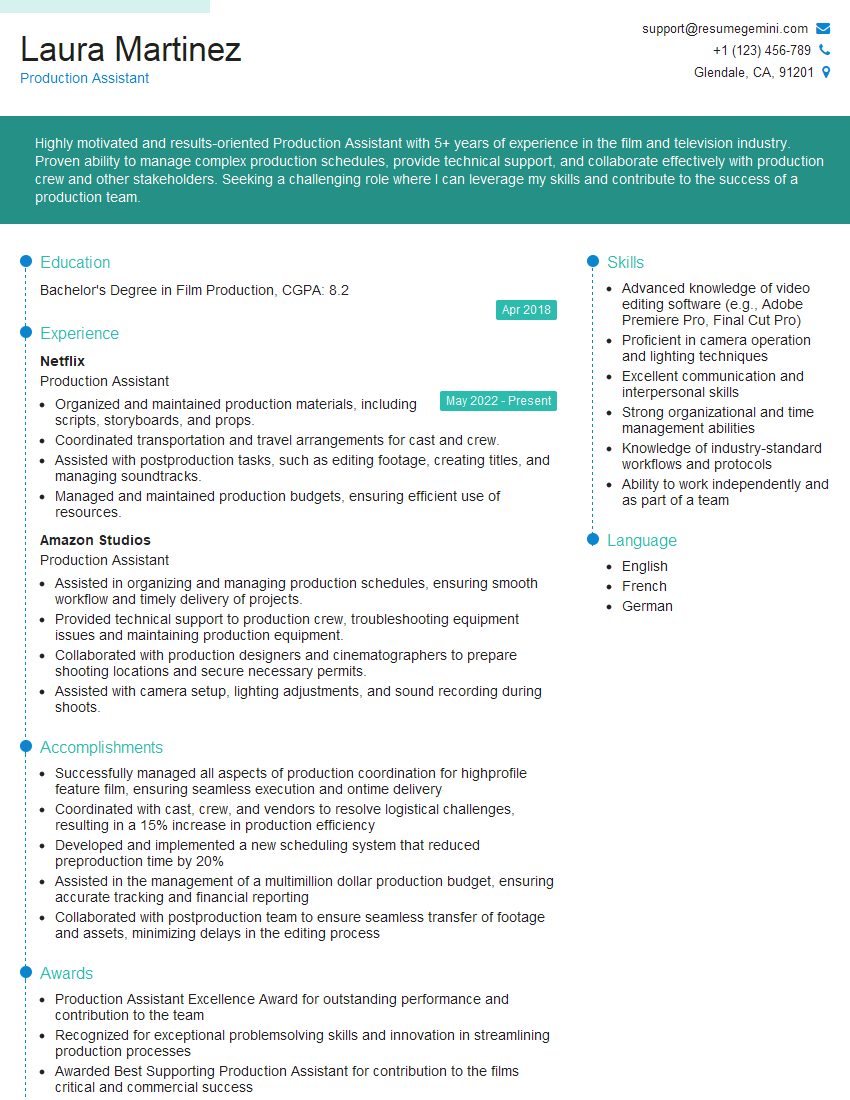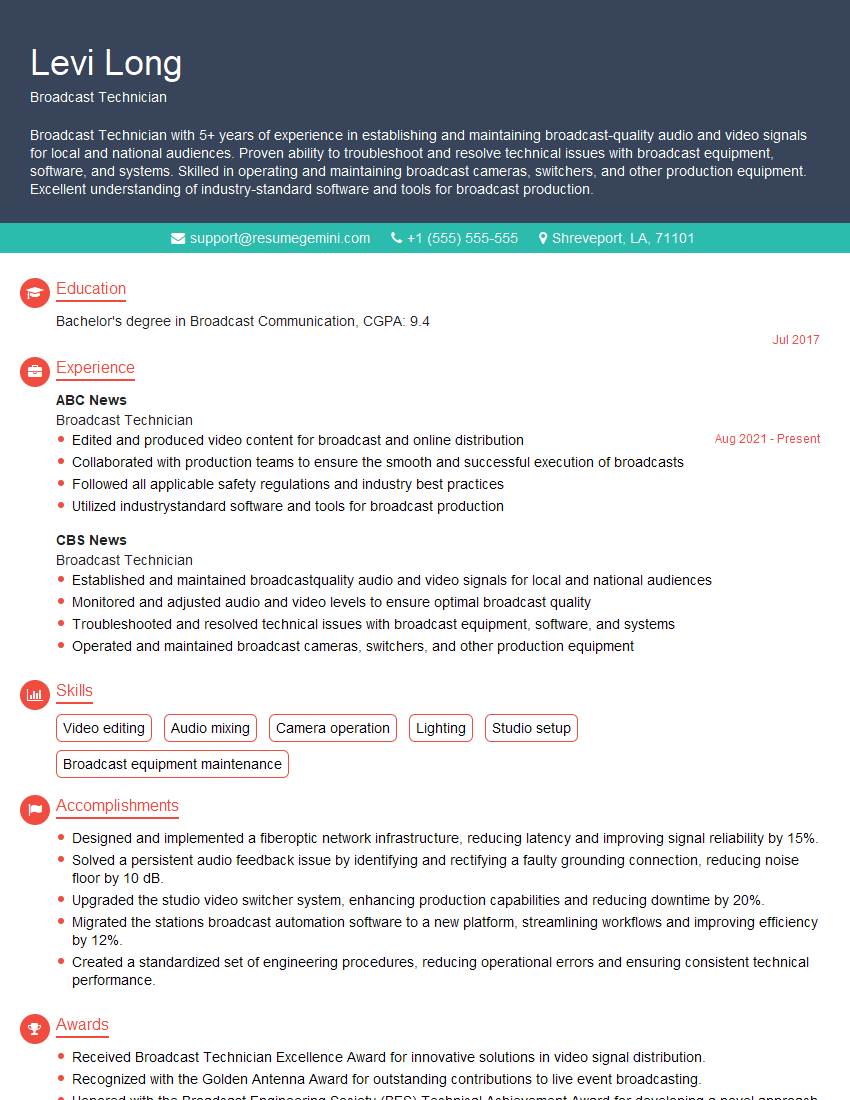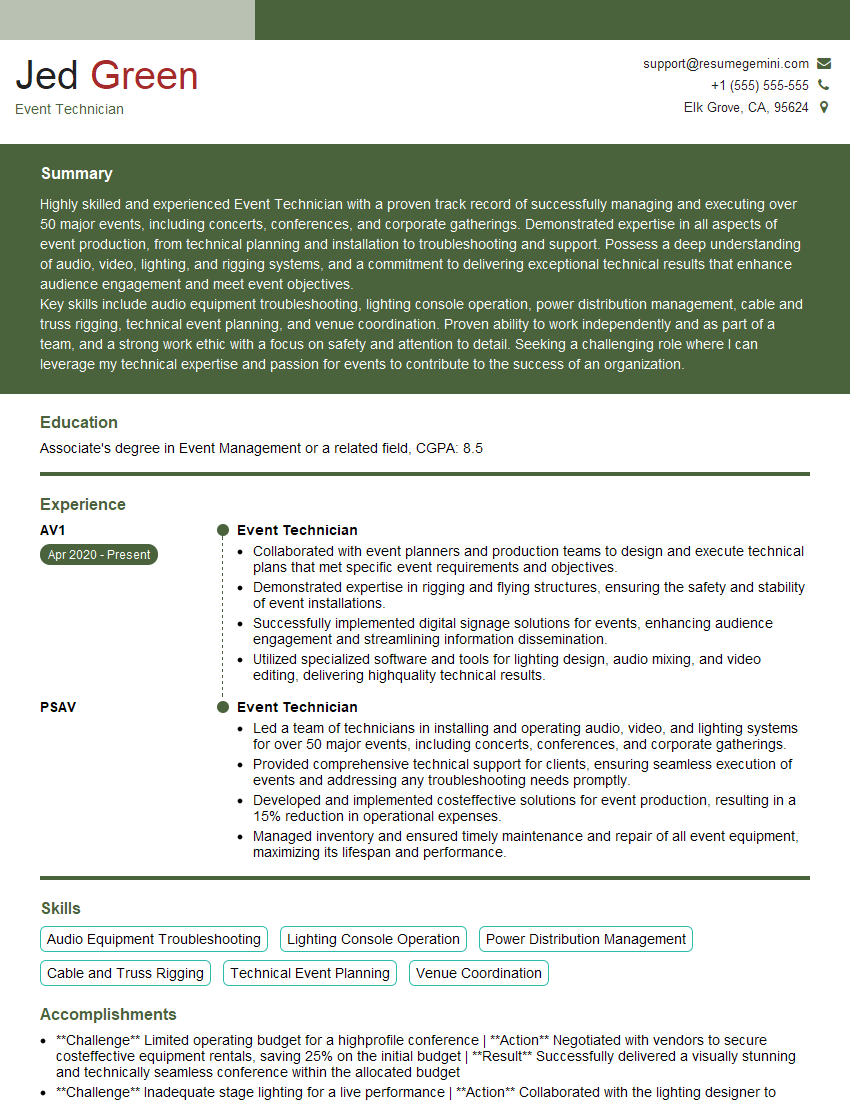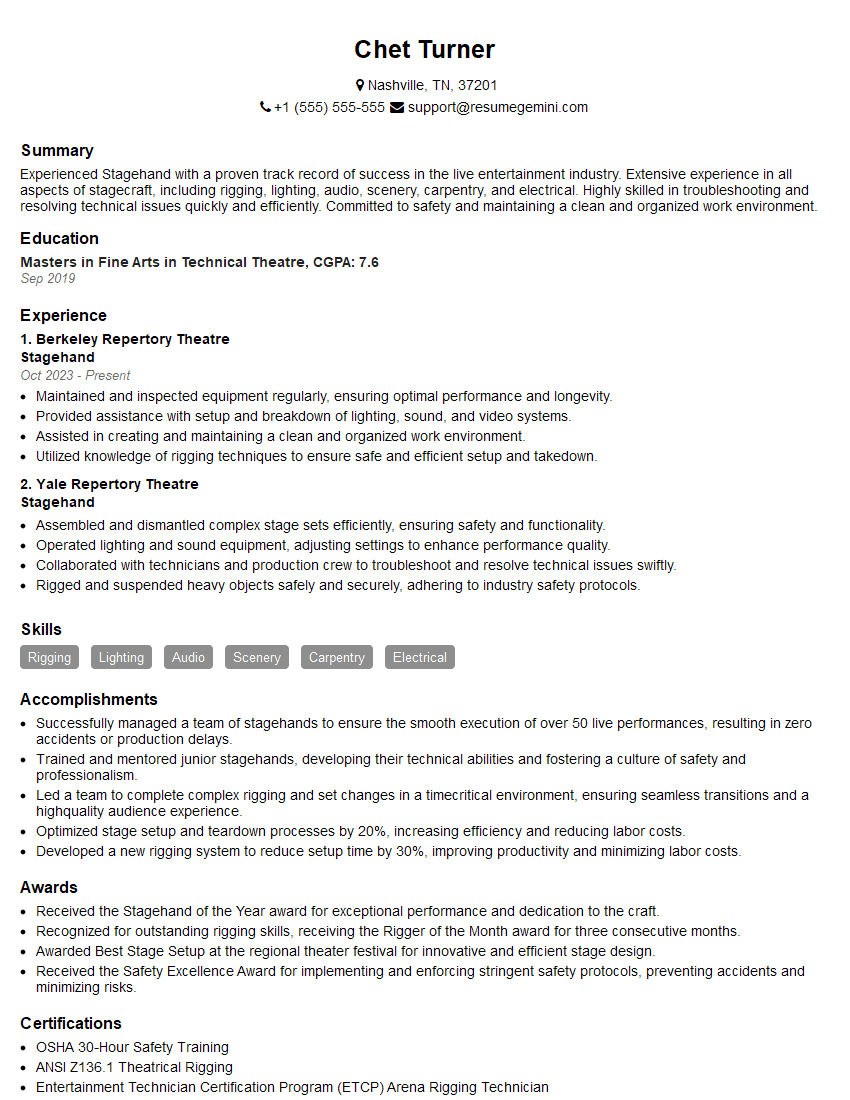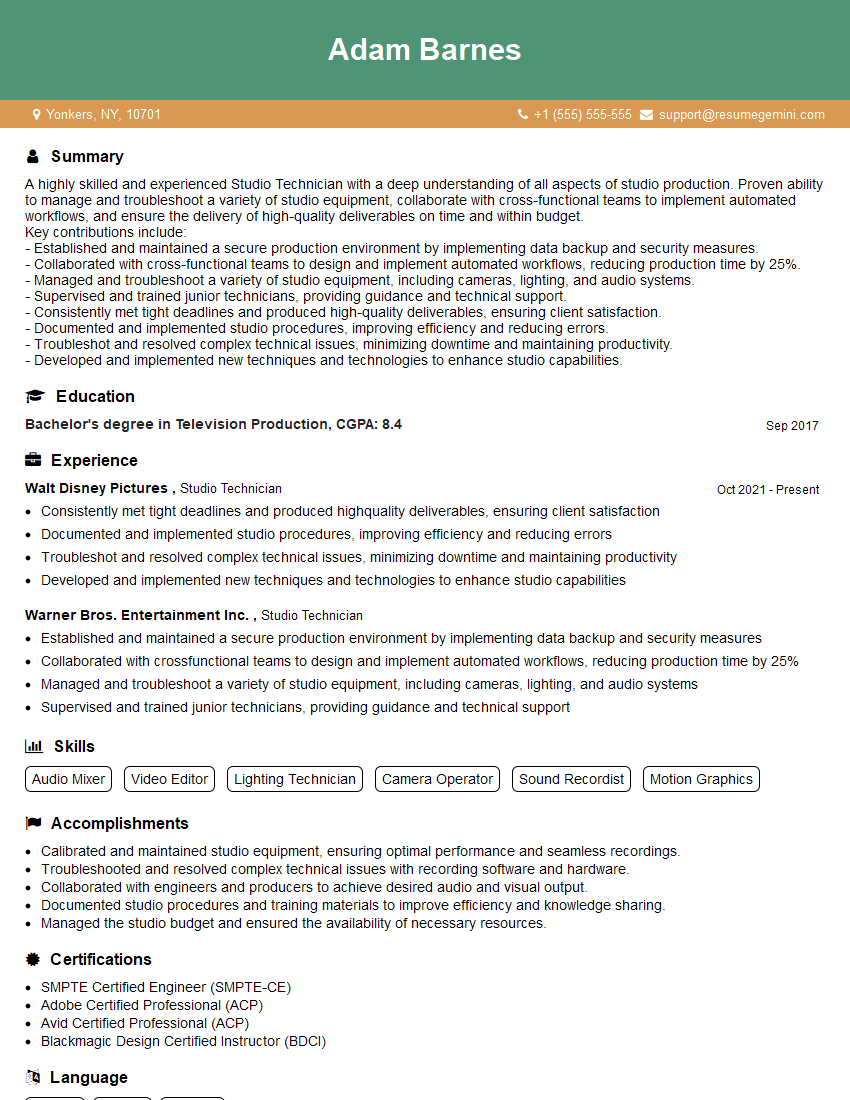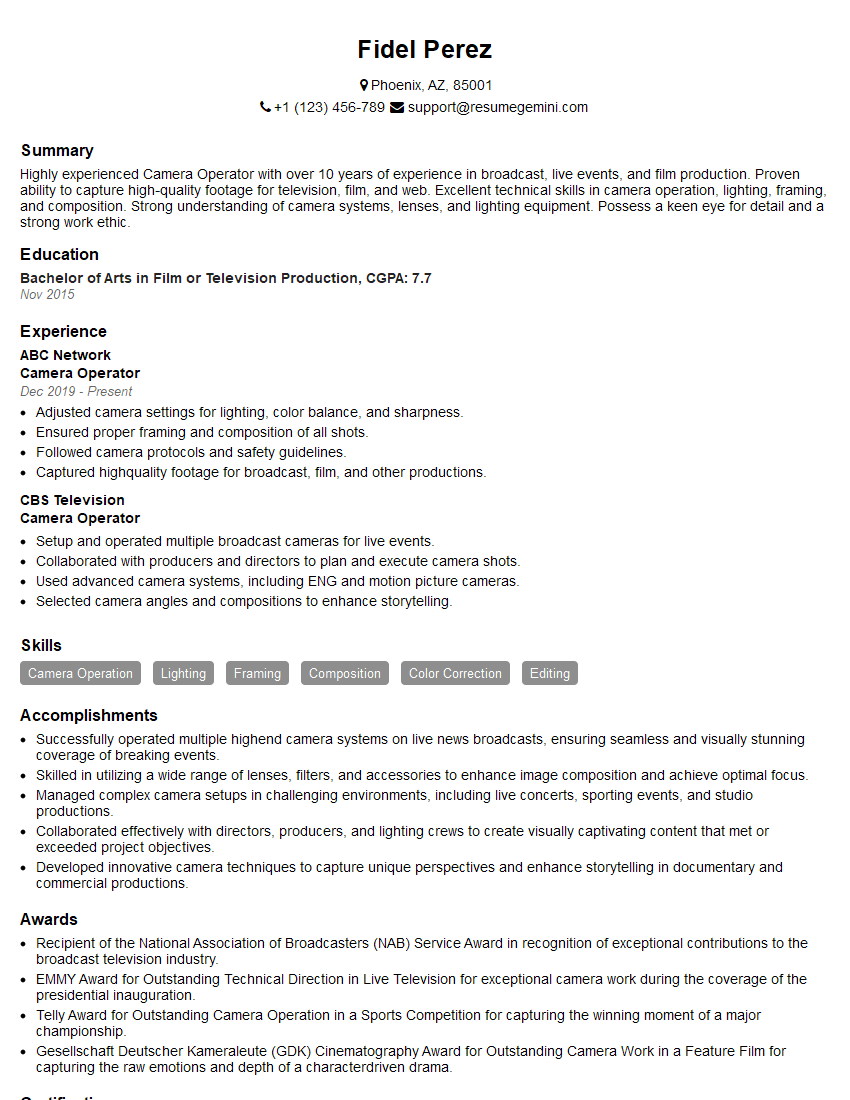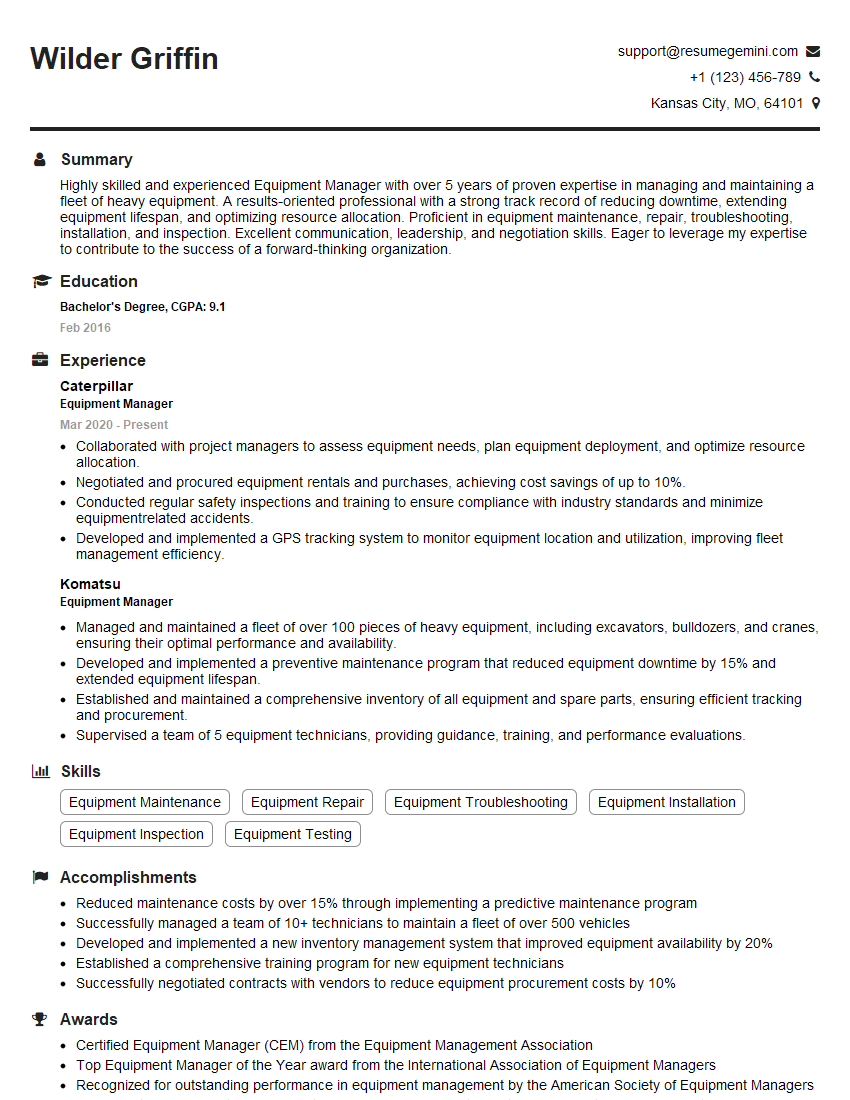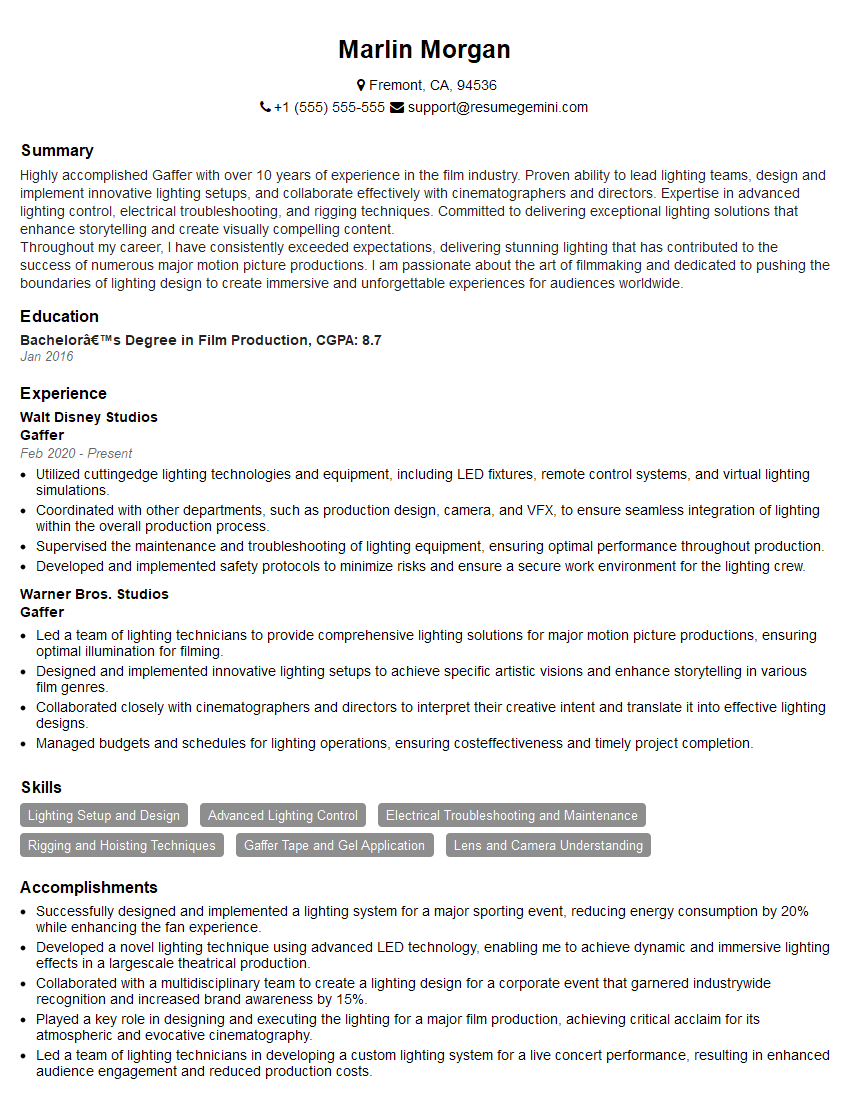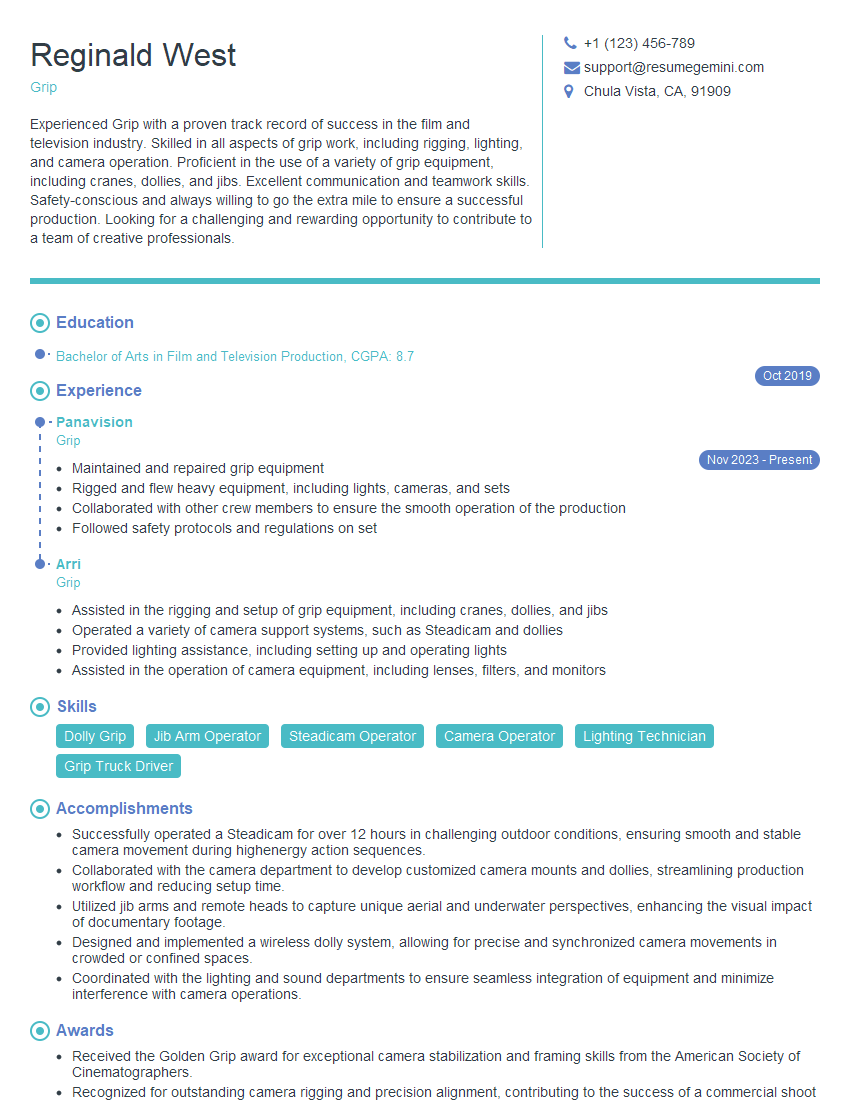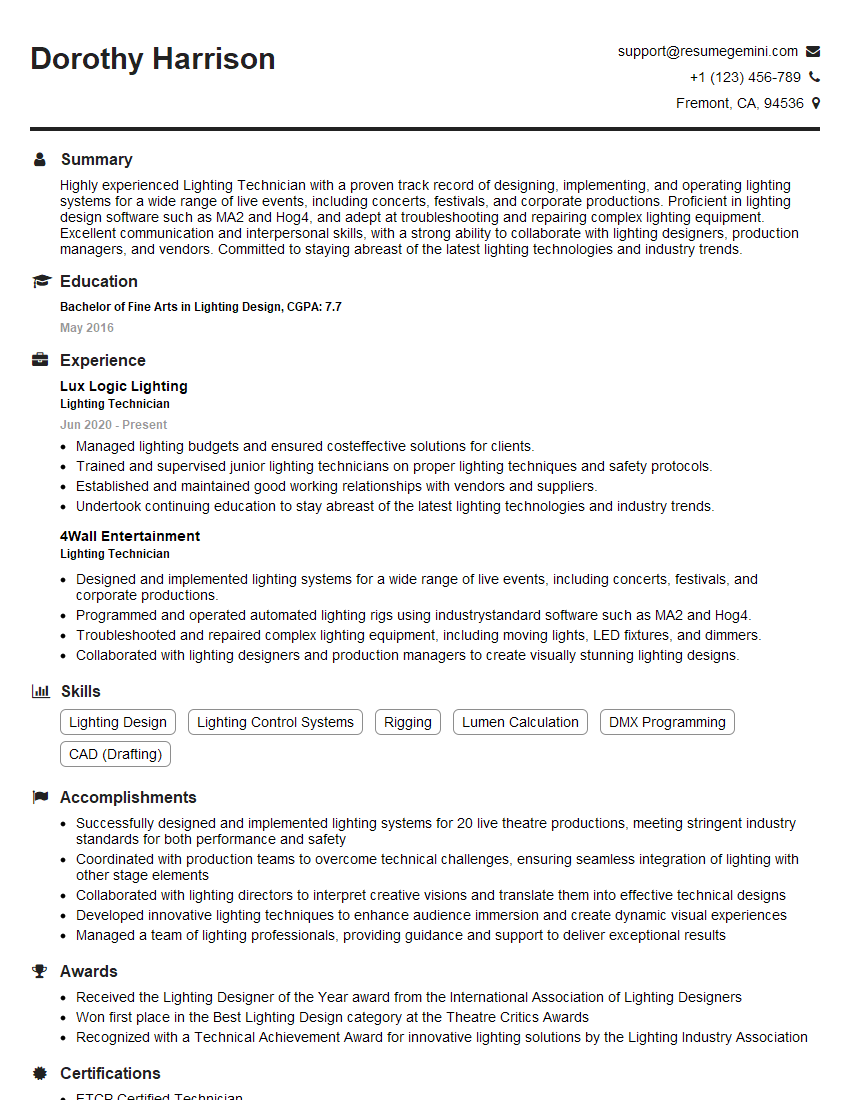Interviews are opportunities to demonstrate your expertise, and this guide is here to help you shine. Explore the essential Tripods interview questions that employers frequently ask, paired with strategies for crafting responses that set you apart from the competition.
Questions Asked in Tripods Interview
Q 1. Explain the different types of tripod heads and their applications.
Tripod heads are the crucial interface between your camera and the tripod legs, dictating how you position and move your equipment. The choice depends heavily on your shooting style and needs. Here are some common types:
- Ball Heads: These offer the most freedom of movement. A ball bearing mechanism allows for smooth, 360-degree panning and tilting. Ideal for quick adjustments and versatile shots, perfect for landscape photography or wildlife where rapid repositioning is key. However, they may require more precise adjustments to achieve perfect leveling.
- Panning Heads: These heads restrict movement primarily to a single axis (pan), though they often allow for independent tilting. They are incredibly stable and provide smooth, controlled panning shots ideal for timelapses, panoramas, or video recording where smooth, precise movement is paramount. They lack the versatility of ball heads.
- Fluid Heads: Designed specifically for video, these heads use fluid drag mechanisms to ensure smooth, controlled movements, minimizing jarring and camera shake. Different levels of drag can be adjusted depending on the camera’s weight and the desired movement speed. Essential for professional videography.
- Gimbal Heads: These heads use a gimbal mechanism for incredible stability and smooth movement, particularly suitable for heavy camera setups and in situations requiring extreme stability, like extreme close-ups or low-light filming. Typically more expensive.
Choosing the right head is crucial. A photographer shooting landscapes might prefer a robust ball head for quick composition changes, while a videographer needs the precision and smoothness of a fluid head.
Q 2. Describe the process of setting up a tripod for optimal stability.
Setting up a tripod correctly is essential for sharp images and stable video. Here’s a step-by-step process:
- Extend the legs: Extend the tripod legs to a suitable height, ensuring they are evenly spread for a wide base. This increases stability, especially on uneven terrain.
- Level the head: Use the tripod’s head leveling mechanism (often a built-in bubble level or adjustable feet) to ensure the head is perfectly level. This is crucial for sharp images and prevents the camera from tilting.
- Attach the camera: Securely attach your camera to the tripod head, ensuring a tight connection. Consider using a quick-release plate for faster setup and removal.
- Adjust the center column: Only extend the center column if absolutely necessary, as this reduces stability. Keep it retracted as much as possible.
- Tighten the leg locks: Securely tighten all leg locks to prevent accidental collapse. Avoid over-tightening which could damage the tripod.
- Test for stability: Gently rock the tripod to check for stability. If it feels unsteady, readjust the leg positions or shorten the center column.
Remember, a stable tripod is the foundation for quality images and video. Taking the time for proper setup pays off in the final results.
Q 3. What are the key factors to consider when choosing a tripod for a specific shooting scenario?
Choosing the right tripod depends on several factors:
- Camera weight and size: The tripod must be able to support the weight of your camera and any additional equipment, such as lenses or microphones. A heavier setup requires a tripod with a higher weight capacity.
- Shooting environment: Consider the terrain. A lightweight tripod is sufficient for a stable surface, while a heavier-duty tripod is better for uneven terrain or windy conditions.
- Shooting style: The type of photography or videography you do impacts your tripod choice. Landscape photographers might prioritize height and stability, while wildlife photographers need quick adjustments and maneuverability.
- Portability: If portability is important, choose a lighter tripod. However, heavier tripods typically offer better stability.
- Budget: Tripods range widely in price. Determine your budget before selecting a tripod.
For example, a wildlife photographer will likely choose a lighter tripod with a ball head for rapid adjustments, whereas a landscape photographer using a large-format camera may need a heavier, more stable tripod with a more robust head.
Q 4. How do you ensure the tripod is properly leveled?
Proper leveling is crucial for preventing camera tilt and ensuring accurate image composition. Most tripods offer multiple methods for leveling:
- Bubble Levels: Many tripod heads and legs include bubble levels. Adjust the legs until the bubbles are centered within their respective markings.
- Adjustable Feet: Some tripods have adjustable feet that allow you to independently adjust the height and angle of each leg. Use these to level the tripod on uneven terrain.
- Head Leveling Mechanisms: Some tripod heads have built-in mechanisms that can be used to level the camera independently of the tripod legs.
When using bubble levels, ensure you check all three levels (usually two on the head and one on the central column) for proper leveling. Don’t rush this process! Proper leveling is paramount, especially for architectural or landscape photography where even minor tilts can ruin the image.
Q 5. Explain the importance of proper tripod leg tension.
Proper tripod leg tension is vital for smooth, controlled movement and preventing accidental collapse. Leg tension is typically adjusted via knobs or clamps on each leg section. Here’s why it’s important:
- Stability: Insufficient tension can lead to wobbly legs, particularly during panning or tilting. The tripod might collapse or shake unexpectedly.
- Smooth operation: Over-tightening makes adjustments difficult and could damage the tripod. You want just enough tension for stability without requiring excessive force to adjust the leg sections.
- Long-term durability: Correct tension ensures the leg locking mechanisms remain intact and prevents premature wear and tear.
Think of leg tension like the brakes on a car – you want them to be firm enough to prevent unwanted movement but not so tight that they’re difficult to operate smoothly. Regularly check and adjust leg tension to maintain stability and tripod longevity.
Q 6. How do you maintain and clean a tripod to extend its lifespan?
Regular maintenance significantly extends a tripod’s lifespan. Here’s how to clean and maintain your tripod:
- Cleaning: Wipe down the tripod legs and head with a soft, damp cloth. Avoid using harsh chemicals or abrasive materials. For stubborn dirt, use a mild soap solution and then thoroughly dry the tripod.
- Lubrication: If you notice any stiffness in the leg movements or head adjustments, consider applying a small amount of silicone-based lubricant (consult your tripod’s manual for recommendations) to the moving parts. Over-lubrication can attract dust and debris, so use sparingly.
- Storage: Store the tripod in a clean, dry place to prevent rust or corrosion. Avoid leaving it in direct sunlight or extreme temperatures.
- Inspect Regularly: Periodically inspect the tripod for loose screws, damage, or signs of wear and tear. Tighten loose screws and address any damage immediately.
A well-maintained tripod is an investment. Regular cleaning and lubrication will keep it performing smoothly and accurately for years.
Q 7. What are the common problems encountered with tripods, and how do you troubleshoot them?
Common tripod problems and their solutions:
- Loose legs or head: Check for loose screws or bolts and tighten them. If the problem persists, it might indicate a more significant issue requiring repair or replacement.
- Sticking legs or head: Clean the moving parts and consider applying a small amount of silicone lubricant. Avoid using excessive force.
- Tripod collapse: Check the leg locks to ensure they’re properly engaged. Inspect the locking mechanisms for damage or wear and tear.
- Uneven leg lengths: Check the leg extensions are properly set. If uneven, adjust accordingly. This may result from wear in the leg sections.
- Bubble level inaccuracies: This usually points to a faulty bubble level. If the bubble is consistently off-center despite correctly leveling the tripod, the bubble level might need replacement.
If you’re unable to troubleshoot the problem yourself, consult the manufacturer’s instructions or contact a professional for repairs.
Q 8. Describe the difference between carbon fiber and aluminum tripods.
The primary difference between carbon fiber and aluminum tripods lies in their material properties, directly impacting weight, strength, and cost. Aluminum tripods are generally heavier but more affordable. They offer good stability for their price but can be cumbersome to carry for extended periods. Carbon fiber tripods, on the other hand, are significantly lighter, making them ideal for travel and long shoots. They also boast superior strength-to-weight ratios, meaning they can support heavy camera setups without being overly bulky. However, they command a higher price point.
Think of it like this: aluminum is like a sturdy, reliable workhorse, while carbon fiber is a sleek, high-performance sports car. Both get the job done, but one prioritizes affordability and practicality, while the other prioritizes performance and portability.
For instance, a professional photographer shooting landscapes might prefer the stability of a heavier aluminum tripod, while a wildlife photographer might opt for the lightweight portability of a carbon fiber tripod, especially when hiking considerable distances.
Q 9. What are the safety precautions when using a tripod, especially in challenging environments?
Safety is paramount when using a tripod, particularly in challenging environments. Always ensure the tripod legs are firmly planted on stable ground, avoiding loose soil or uneven surfaces. In windy conditions, consider using additional weights to increase stability, or even avoid using the tripod altogether if conditions are excessively dangerous. Never extend the tripod legs beyond their maximum capacity, as this compromises stability and increases the risk of collapse.
- Check ground stability: Before setting up, thoroughly assess the ground for stability. Avoid setting up on slopes or uneven surfaces.
- Use appropriate weights: Employ sandbags or tripod weights in windy or unstable environments.
- Secure the tripod: Tighten all leg locks and ensure the tripod head is securely attached to the tripod.
- Mind the terrain: Be aware of your surroundings and potential tripping hazards.
- Avoid overextension: Never extend the tripod legs beyond their maximum recommended height.
During a shoot in a remote area, I once had to secure my tripod to a large rock using straps to counter strong winds. This extra precaution prevented a potentially expensive accident.
Q 10. How do you adjust the tripod height and angle for various shots?
Adjusting tripod height and angle is crucial for achieving the desired shot composition. Most tripods offer adjustable leg sections that allow for precise height control. The angle of the tripod head can then be adjusted for tilting and panning movements. For instance, lowering the tripod can create a low-angle shot, emphasizing the foreground while a higher placement might capture a broad panoramic view.
To adjust the height, simply loosen the leg locks, extend or retract the leg sections to the desired height, and then retighten the locks. The angle of the tripod head (often featuring pan and tilt movements) can be adjusted via its locking mechanisms, allowing you to create dynamic perspectives. Many heads offer a bubble level for precise horizontal alignment.
For instance, when shooting macro photography, I might use the lowest possible tripod setting and adjust the angle of the head to position the camera precisely above the subject. For landscape photography, I typically extend the legs fully, aiming for the most stable and level position.
Q 11. Explain the concept of center of gravity and its relevance to tripod stability.
The center of gravity (CG) is the point at which an object’s weight is evenly distributed. In the context of tripods, the CG is crucial for stability. A lower CG leads to increased stability because it lowers the point at which the tripod might tip over. Factors affecting CG include the weight of the camera gear, the tripod’s design, and the height at which the tripod is extended.
Imagine a seesaw: the closer the weight is to the center, the more balanced it is. The same applies to a tripod. By keeping the center of gravity low and the base wide, you minimize the risk of the tripod tipping, even with heavier camera equipment.
For example, a tripod with a heavy head mounted high on its column will have a higher CG and be less stable than the same tripod with the head positioned lower. Always keep heavy equipment close to the tripod’s center and use counterweights when necessary.
Q 12. Describe your experience working with various tripod accessories (e.g., fluid heads, monopods).
My experience encompasses a wide range of tripod accessories, each contributing to specialized shooting needs. Fluid heads, for example, provide smooth and controlled camera movements, essential for video work and panning shots. They offer precise damping control to prevent jerky movements. Monopods provide a lightweight and portable support solution, ideal for situations where a full tripod might be impractical, like fast-paced sports events. I’ve also worked with various quick-release plates for faster transitions between setups and specialized brackets for attaching additional accessories like lights and microphones.
I once used a combination of a high-quality fluid head, a sturdy carbon fiber tripod, and a follow-focus system to shoot a time-lapse video of a star trail. The fluid head’s smooth panning mechanism and the tripod’s stability were critical for avoiding any unwanted camera shake during the hours-long exposure.
Q 13. How do you handle a tripod malfunction during a critical shoot?
A tripod malfunction during a crucial shoot necessitates quick thinking and problem-solving skills. First, assess the nature of the problem. If it’s a minor issue like a loose screw, tighten it immediately. If a leg breaks, and a repair isn’t feasible, use available resources like sturdy rocks or branches as improvised support (depending on the situation). As a last resort, if camera stability is paramount and no workaround is possible, carefully consider changing to a handheld shot, though this introduces the risk of camera shake.
During one shoot, a leg unexpectedly collapsed due to a manufacturing defect. I quickly improvised by using a large, stable rock as a support base, thereby securing the tripod enough to finish the shoot. Always having a backup plan or an alternative support system is crucial.
Q 14. How do you select the appropriate tripod for different types of cameras and lenses?
Selecting the right tripod depends on factors like camera type, lens size and weight, and shooting style. A lightweight mirrorless camera may only need a smaller, travel-friendly tripod, whereas a professional DSLR with a large telephoto lens requires a much sturdier and heavier-duty tripod. The tripod’s maximum load capacity must always exceed the weight of the camera and lens combination.
Consider the height and extension range necessary for your preferred shooting style. If you regularly shoot landscapes, a tripod with a greater height range will be advantageous. For video work, a tripod with a center column and fluid head will provide smoother movements. For wildlife photography, a lightweight tripod is usually preferable for portability.
I wouldn’t use a lightweight travel tripod for supporting a professional-grade telephoto lens, for example. Choosing a tripod carefully minimizes the risk of equipment damage and ensures optimal image quality.
Q 15. Explain your understanding of tripod weight capacity and its importance.
Tripod weight capacity refers to the maximum weight a tripod can safely support without collapsing or becoming unstable. This is crucial because exceeding the weight capacity can lead to equipment damage, injury, and potentially compromised image quality. It’s expressed in kilograms or pounds and is usually printed on the tripod’s specifications.
For example, a tripod with a 10kg capacity can safely hold a camera, lens, and other accessories weighing up to 10kg. Going beyond this limit risks serious damage to the tripod, potentially causing it to bend or break, and leading to a costly repair or replacement. This is especially important for heavier professional cameras, long telephoto lenses, or additional accessories like microphones or external monitors. You should always factor in the weight of all attached equipment, including any potential additional accessories.
Career Expert Tips:
- Ace those interviews! Prepare effectively by reviewing the Top 50 Most Common Interview Questions on ResumeGemini.
- Navigate your job search with confidence! Explore a wide range of Career Tips on ResumeGemini. Learn about common challenges and recommendations to overcome them.
- Craft the perfect resume! Master the Art of Resume Writing with ResumeGemini’s guide. Showcase your unique qualifications and achievements effectively.
- Don’t miss out on holiday savings! Build your dream resume with ResumeGemini’s ATS optimized templates.
Q 16. Describe your experience using tripods in different terrains (e.g., uneven ground, sand).
My experience with tripods in diverse terrains is extensive. I’ve used them in everything from smooth studio floors to rugged mountain trails and shifting sand dunes. On uneven ground, the key is proper leg adjustment. Many tripods offer individual leg adjustments, allowing me to level the camera even on sloping surfaces. I often use a bubble level to ensure perfect horizontal alignment. In sandy conditions, I’ve found that using wider tripod feet, or adding sandbags to the tripod legs and center column for added stability, helps significantly to prevent sinking.
I remember once working on a beach photoshoot; the sand was particularly soft. The tripod legs were sinking with every adjustment! To counteract this, I spread the legs wide apart and used a sandbag hung from the hook on the center column. This significantly improved the stability and gave me confidence in securing the shot.
Q 17. How do you pack and transport a tripod safely and efficiently?
Safe and efficient tripod transport begins with proper disassembly and organization. I always start by retracting the legs completely and securing them with any included straps or clamps. The head is then carefully detached and stored separately to prevent accidental damage. I then place the tripod in a protective case or bag, padded to prevent impacts during transport. For longer journeys, I often use a dedicated tripod backpack that distributes the weight evenly.
Once I reach my destination, I reverse the process: careful assembly, making sure all parts are firmly attached before mounting my camera equipment. I always double-check the tripod’s stability before starting a shoot. Rushing this process can lead to accidents or unstable shots.
Q 18. What are the limitations of using a tripod, and how do you overcome them?
Tripods, while incredibly useful, have limitations. Wind is a significant factor; strong gusts can easily knock a tripod over, especially those with a higher center of gravity. In these situations, using a weight bag at the base, choosing a low-profile tripod, or finding shelter from the wind are essential. Another limitation is the difficulty of quickly changing angles or composition in dynamic situations. For such scenarios, a monopod can be a good alternative, allowing greater mobility.
I’ve also encountered situations where the tripod is simply too cumbersome for specific environments; navigating dense forests or tight spaces can be challenging. In these cases, I might switch to using image stabilization features on the camera or opting for handheld shots, taking care to minimize camera shake.
Q 19. Describe your experience using specialized tripods for specific applications (e.g., macro photography).
Specialized tripods enhance the capabilities of specific applications. For macro photography, I often use a tripod with a very low-profile design, and sometimes even a macro rail system for incredibly precise focus adjustments. This allows for the ultra-close shots needed for macro work, and minimizes vibrations that could ruin the shot. The stability of the tripod is critical here as even the smallest vibration can be amplified at close range.
Another example is using a video tripod with a fluid head for smooth camera movements. These tripods often incorporate heavier-duty construction, capable of supporting heavier video cameras and equipment. The fluid head makes panning and tilting exceptionally smooth, preventing jerky movements that compromise video quality.
Q 20. How familiar are you with different tripod mounting systems?
I am very familiar with various tripod mounting systems. The most common is the 3/8”-16 UNC threaded stud, which is almost universally used for attaching the tripod head to the tripod legs. Some systems also utilize a 1/4”-20 UNC stud, often seen on smaller, lighter tripods or used as an adapter for additional accessories. Beyond these, various ball heads, pan/tilt heads, and specialized heads designed for video or other applications use different mounting systems, often proprietary to the manufacturer.
Understanding these mounting systems is crucial for compatibility. Using the wrong mount can damage your equipment. I always ensure the correct thread size and type are matched before mounting any component. Using adapters carefully selected for compatibility between different systems, when necessary, allows for the use of a wider range of equipment.
Q 21. Explain your understanding of the relationship between tripod stability and image sharpness.
The relationship between tripod stability and image sharpness is direct and crucial. A stable tripod minimizes vibrations and camera shake, resulting in sharper images, particularly at slower shutter speeds or with telephoto lenses. Any movement during exposure will blur the resulting image, so a tripod’s ability to remain perfectly still is critical to image quality.
For example, if you’re shooting a landscape at sunset with a long exposure to capture the glow of the sky, even a slight vibration will create a blurry image. A sturdy tripod with properly adjusted legs minimizes these vibrations allowing for the capture of crisp, detailed images even at slow shutter speeds. Investing in a high-quality tripod is an investment in the sharpness and quality of your photographs.
Q 22. How do you ensure the tripod is compatible with the camera and other accessories?
Tripod compatibility hinges on two key aspects: the camera mounting system and the accessory mounting points. Most tripods use a standard 1/4-20” screw mount for cameras, but it’s crucial to verify this. Check your camera’s specifications; some professional cameras might have alternative mounts. For accessories like lights or microphones, look for compatibility with the tripod’s mounting brackets or hot-shoe connections. Some tripods offer specialized attachments for specific accessories. Always double-check the specifications of both your tripod and accessories before purchase or use to avoid incompatibility issues.
For instance, if you’re using a heavy-duty camera like a DSLR, you need a tripod with a robust center column and a high load capacity. Conversely, a lightweight compact camera can work perfectly with a smaller, lighter tripod.
Q 23. How do you prevent tripod slippage on various surfaces?
Preventing tripod slippage depends on understanding the surface and choosing the right tripod feet. For hard surfaces like concrete or tile, rubber feet provide sufficient grip. However, on softer ground like grass or sand, you’ll need spiked feet or wide-base feet for increased stability. Another crucial aspect is the tripod’s weight and center of gravity. A heavier tripod with a low center of gravity will be more resistant to tipping. For extra stability on uneven surfaces, consider using a tripod with adjustable leg angles.
In my experience, I’ve found that adding a small weight bag to the tripod’s center column significantly improves stability, particularly in windy conditions or on slopes. Additionally, always ensure the tripod legs are firmly extended and locked into place.
Q 24. What are the key features to consider when purchasing a tripod?
Selecting a tripod involves considering several key features: Load capacity: This determines the maximum weight the tripod can support. Choose a tripod that comfortably exceeds your camera and accessory weight. Height and leg angles: Consider the minimum and maximum height, as well as the leg angles’ adjustability, for versatility in various shooting situations. Material: Aluminum is lightweight and affordable, while carbon fiber offers superior strength and lightness at a higher price. Head type: Ball heads offer smooth, fluid movements, while pan-tilt heads provide more precise control. Consider your shooting style and needs.
For example, a landscape photographer might need a sturdy tripod with a high maximum height, while a wildlife photographer might prioritize a lightweight, portable tripod with a quick-release mechanism. Budget also plays a significant role, as higher-end tripods offer superior quality and features, while entry-level options are ideal for occasional use.
Q 25. Describe your experience working with different brands of tripods.
I’ve worked extensively with various brands, including Manfrotto, Gitzo, and Vanguard. Manfrotto tripods are known for their reliability and wide range of accessories, making them suitable for a variety of applications. Gitzo tripods stand out for their superior quality and lightweight carbon fiber construction, ideal for professional photographers who prioritize portability. Vanguard offers a good balance between price and performance, suitable for both beginners and intermediate users.
Each brand has its strengths and weaknesses. For example, while Gitzo tripods are renowned for their exceptional stability, they are typically more expensive. My choice of brand often depends on the specific project and the client’s budget and requirements.
Q 26. How do you assess the quality and durability of a tripod?
Assessing tripod quality and durability involves a multi-faceted approach. First, inspect the materials for sturdiness and signs of cheap manufacturing. Check the joints for smooth operation and secure locking mechanisms. Pay attention to the tripod’s weight and overall construction; a well-built tripod feels substantial and stable. Test the leg adjustments and the head’s fluidity. Look for features that indicate durability, such as reinforced leg sections and high-quality materials. Read reviews and check the manufacturer’s warranty to gauge user experience and longevity.
For instance, I once encountered a tripod where the leg lock mechanisms felt flimsy and prone to failure. This indicated poor quality and potential issues in the long run. Conversely, a well-made tripod should withstand considerable stress with minimal flex or instability.
Q 27. Explain your experience with using remote tripod heads or motorized systems.
My experience with remote tripod heads and motorized systems has been overwhelmingly positive, particularly in time-lapse photography and cinematic work. These systems provide precise control and allow for smooth, automated camera movements. Motorized heads are especially useful for creating professional-looking panning shots or time-lapses without the need for manual adjustments. Remote control features can also be invaluable for minimizing vibrations and improving image stability when working in challenging environments.
One project involved using a motorized head to create a time-lapse of a sunset. The precise control of the head allowed for smooth tracking of the sun’s movement, resulting in a stunning visual effect that would have been impossible to achieve manually.
Q 28. How would you explain the use and importance of a tripod to a non-technical person?
Imagine you’re trying to take a picture of a beautiful landscape. If you hold the camera in your hands, even a slight shake can blur the image. A tripod is like a stable platform for your camera, eliminating those shaky hands. It lets you take crystal-clear photos, especially when using slower shutter speeds or in low-light conditions. It also allows for more creative compositions and camera angles that are impossible to achieve while hand-holding the camera. Think of it as a sturdy friend that ensures your photos are always sharp and perfect!
It’s especially useful for capturing images with long exposure times, where even minor movement can ruin the shot. Beyond photography, tripods are valuable for videography, ensuring steady footage for professional-looking videos.
Key Topics to Learn for Tripods Interview
- Mechanical Design: Understanding the principles of stability, load distribution, and center of gravity in tripod structures. Consider different leg configurations and their impact on stability.
- Material Science: Knowledge of appropriate materials for tripod legs and heads based on strength, weight, and environmental factors. Analyze material properties and their impact on performance.
- Manufacturing Processes: Familiarity with various manufacturing techniques used in tripod production, such as casting, machining, and welding. Understand the trade-offs between different methods.
- Head Mechanisms: Deep understanding of different tripod head designs (ball heads, 3-way heads, geared heads) and their applications. Analyze the advantages and disadvantages of each type.
- Motion Control & Stability: Explore how tripod designs minimize vibrations and ensure smooth, controlled movements. Consider the impact of damping and friction.
- Quality Control & Testing: Understand the importance of quality control measures and testing procedures to ensure tripod durability and reliability. Analyze different testing methodologies.
- Ergonomics & Usability: Consider the design aspects related to user comfort and ease of use, including leg adjustability, locking mechanisms, and overall weight.
- Applications & Use Cases: Analyze the varied applications of tripods across different industries, such as photography, surveying, filmmaking, and industrial settings.
Next Steps
Mastering Tripods knowledge opens doors to exciting career opportunities in engineering, manufacturing, and design. A strong understanding of tripod mechanics and design is highly valued across various industries. To maximize your chances of landing your dream job, creating a compelling and ATS-friendly resume is crucial. ResumeGemini is a trusted resource to help you build a professional resume that highlights your skills and experience effectively. Examples of resumes tailored to Tripods roles are available to help guide your creation process.
Explore more articles
Users Rating of Our Blogs
Share Your Experience
We value your feedback! Please rate our content and share your thoughts (optional).
What Readers Say About Our Blog
Interesting Article, I liked the depth of knowledge you’ve shared.
Helpful, thanks for sharing.
Hi, I represent a social media marketing agency and liked your blog
Hi, I represent an SEO company that specialises in getting you AI citations and higher rankings on Google. I’d like to offer you a 100% free SEO audit for your website. Would you be interested?
